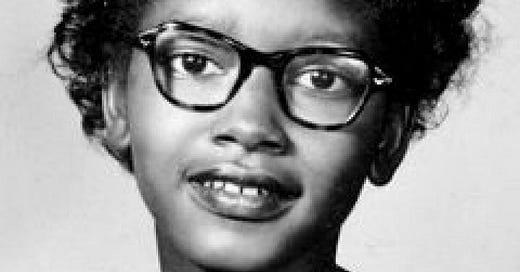The Civil Rights Heroine You Probably Haven't Heard Of
Many of the heroes and heroines of the Civil Rights Movement have become household names, and rightly so. We know all about people like Martin Luther King, Andrew Young, and John Lewis.
But because the Civil Rights Movement is such a key part of the history of the South, it surprised me to learn about one heroine whose name should be more common than it is.
Did you know that Rosa Parks wasn’t the first female to take a stand by refusing to stand and give a white person her seat on a bus in Montgomery, Ala.? Nine months before Parks became a heroine and a cause célèbre, there was Claudette Colvin.
“Who,” you may ask?
Colvin was arrested on March 2, 1955 for refusing to move to the back of the bus. She was 15 years old.
In 2009, she told her story to NPR:
The bus driver ordered her to get up and she refused, saying she'd paid her fare and it was her constitutional right. Two police officers put her in handcuffs and arrested her. Her school books went flying off her lap.
"All I remember is that I was not going to walk off the bus voluntarily," Colvin says.
It was Negro history month, and at her segregated school they had been studying black leaders like Harriet Tubman, the runaway slave who led more than 70 slaves to freedom through the network of safe houses known as the Underground Railroad. They were also studying about Sojourner Truth, a former slave who became an abolitionist and women's rights activist.
Colvin said that those lessons from history played into her decision to not give in so easily.
“My head was just too full of black history, you know, the oppression that we went through. It felt like Sojourner Truth was on one side pushing me down, and Harriet Tubman was on the other side of me pushing me down. I couldn't get up."
Colvin also remembers the moment the jail door closed. It was just like a Western movie, she says.
"And then I got scared, and panic come over me, and I started crying. Then I started saying the Lord's Prayer.”
So why didn’t Colvin become the female face of the Civil Rights Movement? Because even important historical movements concern themselves with optics.
For starters, Colvin was a teenager. More scandalously, she became pregnant out of wedlock before she went to trial. It was said she didn’t have “good hair,” and leaders of the movement thought that Parks was a better-looking and more sympathetic role model.
"Her skin texture was the kind that people associate with the middle class," Colvin told NPR. "She fit that profile."
Colvin lost friends after the incident, and classmates labeled her an “extremist.”
But she got the last laugh as one of the plaintiffs in Browder v. Gayle, the case that finally overturned the bus laws in Montgomery.
Colvin moved to New York City, raised her children, and worked in nursing. She’s still alive and still overlooked by history — even after becoming the subject of a book. She has said that she’s disappointed but not angry for not becoming as well-known as others.
In 2000, Troy University opened a Rosa Parks Museum in Montgomery. The organizers asked her if she wanted to make a video telling her story, but she said no.
"They've already called it the Rosa Parks museum, so they've already made up their minds what the story is,” Colvin told the Guardian.
Here’s to you, Claudette Colvin, for your unsung heroism and for blazing a trail without the recognition that others have received.
The Visibility Project, Claudette Colvin, Public domain, via Wikimedia Commons




